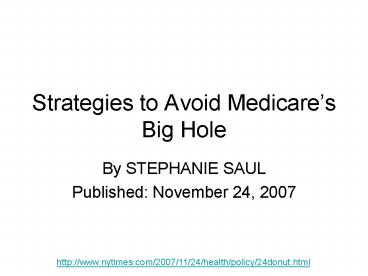Strategies to Avoid Medicares Big Hole - PowerPoint PPT Presentation
1 / 6
Title:
Strategies to Avoid Medicares Big Hole
Description:
And that is not expected to change next year, when the doughnut hole the ... (Donut Hole) begins at this point. ( The. Beneficiary pays 100% of their ... – PowerPoint PPT presentation
Number of Views:51
Avg rating:3.0/5.0
Title: Strategies to Avoid Medicares Big Hole
1
Strategies to Avoid Medicares Big Hole
- By STEPHANIE SAUL
- Published November 24, 2007
http//www.nytimes.com/2007/11/24/health/policy/24
donut.html
2
Medicare Doughnut Hole
- The Medicare doughnut hole is the federal
provision that older Americans love to hate. - And that is not expected to change next year,
when the doughnut hole the nickname for a big
financial gap in each persons Medicare
prescription drug coverage gets slightly
larger. If the past is a guide, many people will
struggle to secure a full years supply of the
drugs they need. - But despite the arrangements unpopularity with
older consumers, some experts see a positive
public policy trend when they peer into the
doughnut hole. Because it potentially forces a
Medicare enrollee to pay more than 3,000 from
his or her own pocket during the gap period, the
hole is helping curb growth in the nations drug
spending by pushing people toward low-cost
generic drugs. - And because the cheaper generics generally work
just as well, patients are incorporating them
into their permanent drug regimen, according to
Dr. Tim Anderson, a pharmaceuticals analyst for
Sanford C. Bernstein Company, who is also a
physician.
3
How it Works
Initial Coverage Limit - Coverage Gap (Donut
Hole) begins at this point. (The Beneficiary
pays 100 of their prescription costs up to the
Out-of-Pocket Threshold)
Deductible - (after the Deductible is met,
Beneficiary pays 25 of covered costs up to
total prescription costs meeting the Initial
Coverage Limit.
Doughnut Hole
2008 Parameters
4
Generics?
- It may not be a message that brand-name drug
makers want to hear. But with the Medicare Part D
drug program enrollment period now under way,
through Dec. 31, analysts predict millions of
older Americans will study generic drug prices
and options as they select an insurance plan.
Some economists say that many Medicare enrollees,
through carefully planned use of generics, can
avoid reaching the doughnut hole altogether. - When the Medicare Part D program began in January
2006, makers of name-brand drugs considered it a
welcome stimulus to overall use of prescription
drugs. The industry knew the doughnut hole might
steer some patients toward generic drugs, but not
necessarily so soon. - I dont think they anticipated how quickly this
kind of event could shift patients toward
utilizing generics, said Peter C. Demogenes, a
senior director of the research firm Wolters
Kluwer.
5
How it got this way
- Congress carved the doughnut hole into the
Medicare prescription drug plan as a way to limit
the federal outlay. But architects of the plan
made sure some costs were covered for all
Medicare beneficiaries upfront, while also seeing
to it that the sickest would get help with
catastrophic drug costs on the far side of the
doughnut hole. Once a beneficiary has made it
through the coverage gap in any given year in
2008, after the total cost of drugs has reached
5,726 prescriptions are generally covered at
95 percent. - About 4.2 million people reached the gap last
year, according to a Wolters Kluwer study, and
many of them switched to generics as a way to
keep their out-of-pocket costs low. Others
started using generic drugs even before they
reached the doughnut hole to avoid the higher
co-payments their policies charged for brand-name
drugs. - In 2006, an estimated 59.6 percent of the Part D
prescriptions were filled by generic drugs. By
the first quarter of 2007, the most recent period
for which data are available, the generic rate in
Medicare had edged higher, to 61.5 percent,
according to Medicare figures.
6
The Economics
Switch to Generics

